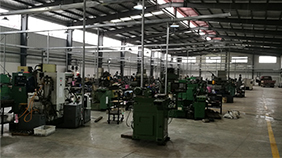Exploring the Benefits and Features of Industrial Walking Foot Sewing Machines for Professional Tailoring
The Evolution and Importance of Industrial Walking Foot Sewing Machines
In the realm of textile manufacturing and garment production, efficiency and precision are paramount. Among the various types of sewing machines used in industrial settings, the walking foot sewing machine stands out as a crucial tool that has revolutionized how complex fabrics are stitched together. Renowned for its unique feeding mechanism and exceptional versatility, this machine has become indispensable in the sewing industry.
The walking foot sewing machine is distinct from traditional sewing machines due to its specialized feeding system. Unlike standard machines that employ a presser foot and feed dogs for fabric movement, walking foot models utilize an additional walking foot mechanism that grips the fabric from the top and moves it in tandem with the feed dogs beneath. This coordinated movement ensures equal feeding of multiple layers of fabric, preventing slippage and misalignment—a common challenge when working with heavyweight materials like leather, canvas, and quilted fabrics. This capability makes the walking foot machine ideal for a variety of applications, from upholstery to outdoor gear and high-quality garment construction.
One of the significant advantages of walking foot sewing machines is their ability to handle difficult materials. In industries where durability is essential, such as in the production of workwear, tents, and tarpaulins, the walking foot machine excels. It provides a robust solution for sewing together thick layers, ensuring that seams are not only secure but also aesthetically pleasing. By minimizing puckering and distortion, these machines contribute to the high standards required in commercial sewing.
industrial walking foot sewing machine

The versatility of the walking foot sewing machine extends beyond just fabric types; it can accommodate various stitching patterns and techniques. Many models come equipped with adjustable stitch lengths and specialized feet that allow for decorative stitching, making them suitable for creative projects as well as heavy-duty applications. This adaptability has made the walking foot sewing machine a favorite among not just industrial manufacturers but also hobbyists and small-scale entrepreneurs.
Over the years, advancements in technology have further enhanced the functionality of walking foot sewing machines. Modern models often incorporate computerized systems, allowing for precision sewing and the ability to program intricate patterns. Features such as automatic thread cutting, needle up/down functions, and programmable stitch settings have streamlined operations in busy production environments, resulting in increased productivity and reduced labor costs.
Moreover, with the growing emphasis on sustainable and ethical manufacturing practices, the reliability and efficiency of walking foot machines play a vital role in supporting these efforts. By ensuring efficient use of materials through precise stitching, manufacturers can minimize waste and optimize their resource management. The ability to produce high-quality products that stand the test of time is crucial in a market that increasingly values longevity and sustainability.
In summary, the industrial walking foot sewing machine has cemented its position as a vital asset in the textile and garment sectors. Its unique design and superior feeding mechanism cater to the demands of various industries, making it the go-to choice for working with challenging fabrics. As technology continues to evolve, these machines are likely to become even more sophisticated, further enhancing their capabilities and the quality of work produced. As manufacturers strive to meet the ever-increasing demands for efficiency and quality, the walking foot sewing machine remains an essential tool in the world of industrial sewing.
-
Leather Sewing Machine: The Industrial Standard for Tough MaterialsNewsJul.18,2025
-
Sail Making Machine: Heavy-Duty Stitching for Industrial and Marine NeedsNewsJul.18,2025
-
Sling Sewing Machine: The Backbone of Heavy-Duty FabricationNewsJul.18,2025
-
Leather Sewing Machine: Precision for Heavy-Duty StitchingNewsJul.18,2025
-
Big Bag Sewing Machine: Powering the Future of Bulk PackagingNewsJul.18,2025
-
FIBC Sewing Machine: Essential Equipment for Bulk Bag ProductionNewsJul.18,2025
-
Heavy Duty Leather Sewing Machine: A Must-Have for Professional LeatherworkNewsMay.28,2025





























